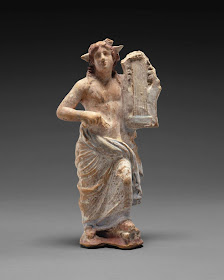 |
| Greek culture in South Italy Apollo ca. 200-100 BC painted terracotta statuette Getty Museum, Los Angeles |
OF A STATUE OF APOLLO
Eutychides stole Phoebus the detector of thieves, saying, "Speak not too much, but compare thy art with mine and thy oracles with my hands and a prophet with a thief and a god with Eutychides. And because of thy unbridled tongue thou shalt be sold at once, and then say of me what thou wilt to thy purchasers."
– epigram by Lucilius (1st century AD), from Book 11 of the Greek Anthology, translated by W.R. Paton (1916-18)
 |
| Rome Head of Apollo ca. 100 BC-AD 50 marble British Museum |
 |
| Rome Apollo 1st century BC-1st century AD amethyst intaglio Hermitage, Saint Petersburg |
 |
| Rome Head of Apollo 1st-2nd century AD marble British Museum |
 |
| Rome Head of Apollo (formerly known as the Lansdowne Artemis) 1st-2nd century AD marble Los Angeles County Museum of Art |
There the sons of the Achaians might have taken gate-towering Ilion
under the hands of Patroklos, who raged with the spear far before them,
had not Phoibos Apollo taken his stand on the strong-built
tower, with thoughts of death for him, but help for the Trojans.
Three times Patroklos tried to mount the angle of the towering
wall, and three times Phoibos Apollo battered him backward
with the immortal hands beating back the bright shield. As Patroklos
for the fourth time, like something more than a man, came at him
he called aloud, and spoke winged words in the voice of danger:
'Give way, illustrious Patroklos: it is not destined
that the city of the proud Trojans shall fall before your spear
nor even at the hand of Achilleus, who is far better than you are.'
* * *
And Patroklos charged with evil intention in on the Trojans.
Three times he charged in with the force of the running war god,
screaming a terrible cry, and three times he cut down nine men;
but as for the fourth time he swept in, like something greater
than human, there, Patroklos, the end of your life was shown forth,
since Phoibos came against you there in the strong encounter
dangerously, nor did Patroklos see him as he moved through
the battle, and shrouded in a deep mist came in against him
and stood behind him, and struck his back and his broad shoulders
with a flat stroke of the hand so that his eyes spun. Phoibos
Apollo now struck away from his head the helmet
four-horned and hollow-eyed, and under the feet of the horses
it rolled clattering, and the plumes above it were defiled
by blood and dust.
– from the Iliad of Homer (book 16) translated by Richmond Lattimore (1951)
 |
| Rome Apollo 2nd century AD marble British Museum |
 |
| Rome Torso of Apollo Lykeios AD 130-160 marble Metropolitan Museum of Art, New York |
 |
| Rome Apollo AD 175-200 marble Prado, Madrid |
 |
| Rome Apollo 2nd century AD marble Hermitage, Saint Petersburg |
 |
| Baccio Bandinelli Apollo ca. 1550 marble Boboli Gardens, Florence |
 |
| François Duquesnoy Apollo and Cupid 1630s bronze Liechtenstein Museum, Vienna |
DESCRIPTION OF A BRONZE STATUE OF APOLLO
There stood Phoebus who speaketh from the tripod. He had bound up behind his loosely flowing hair. In the bronze he was naked, because Apollo knoweth how to make naked to them who enquire of him the true decrees of Fate, or because he appeareth to all alike, for King Phoebus is the Sun and his pure brilliancy is seen from afar.
– epigram by Christodorus of Thebes, from Book 2 of the Greek Anthology, translated by W.R. Paton (1916-18). Book 2 consists of one extended description by Christodorus "of the bronze statues in the celebrated gymnasium called Zeuxippos, erected under Septimius Severus in Byzantium and destroyed by fire shortly after this was written (in 532 A.D.)"
 |
| Ferdinando Tacca Apollo slaying Python ca. 1640-80 bronze Hermitage, Saint Petersburg |
 |
| Antonio Raggi Bust of Apollo before 1686 terracotta Hermitage, Saint Petersburg |
 |
| Antonio Canova Apollo crowning himself 1781-82 marble Getty Museum, Los Angeles |
PRAYER TO APOLLO
"O King, Far-shooter, curb the force of thy bow with which thou didst lay low the Giant's might. Open not thy wolf-slaying quiver, but aim at these young men the arrow of Love, that strong in the friendship of their youthful peers, they may defend their country; for it sets courage afire, and He is ever of all gods the strongest to exalt the hearts of the foremost in the fight. But do thou, whom the Shoenians reverence as their ancestral god, accept the gifts Melistion proffers."
– epigram by Phaedimus (ca. 300 BC), from Book 13 of the Greek Anthology, translated by W.R. Paton (1916-18). "Melistion was evidently one of the celebrated "holy regiments" of Thebes. It consisted of lovers and beloved."
 |
| John Flaxman Pastoral Apollo 1825 marble Petworth House, Sussex |